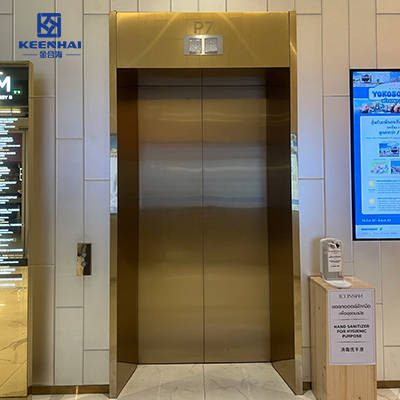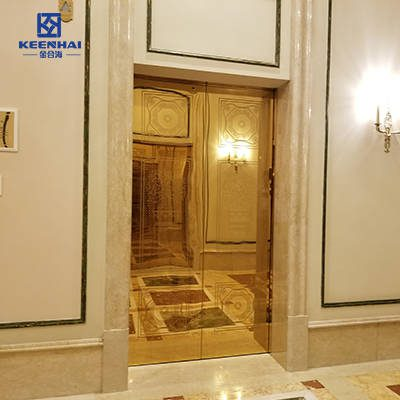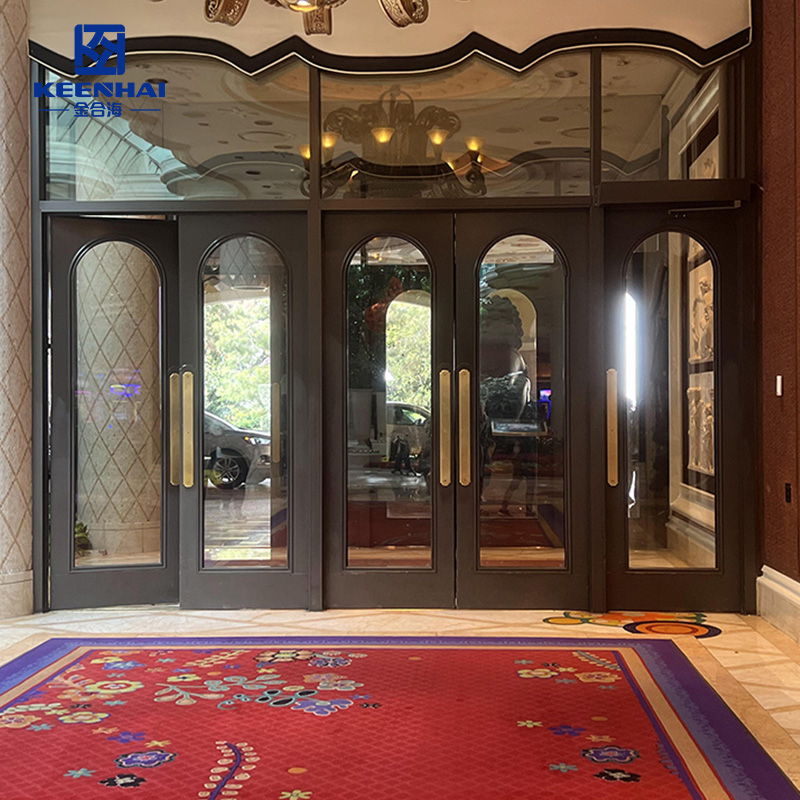PVD stainless steel cladding is a high-performance material where a thin metallic layer bonds to stainless steel at the atomic level. This process enhances hardness, corrosion resistance, and color stability. Ideal for commercial facades, columns, and elevator interiors, it keeps its finish vibrant for over a decade while requiring minimal maintenance. Designers favor it for long-lasting aesthetics and structural reliability.
1.Definition and Basic Concept
1.2What “PVD” Means in Stainless Steel
When we talk about PVD, we’re talking about Physical Vapor Deposition — a vacuum-based technology that bonds a thin metallic layer onto stainless steel. Unlike spray coatings or electroplating, this process doesn’t rely on chemicals or paint. Instead, it works at the atomic level. Inside a sealed vacuum chamber, metals like titanium or zirconium are vaporized, and those vapor particles are drawn toward the steel surface. As they condense, they create a dense, hard film that’s just a few microns thick yet incredibly durable.
Architects love this technology because it gives them creative control without sacrificing performance. For instance, the PVD-coated stainless cladding panels used in modern airports or hotel lobbies don’t fade or peel, even after years of UV exposure and cleaning cycles. That’s because the PVD layer becomes part of the metal — not just something sitting on top of it. The finish stays consistent whether it’s brushed, mirror-polished, or patterned.
The process can be summarized in three precise stages:
-
Surface Preparation – The stainless steel is cleaned with plasma to remove every trace of oil and dust.
-
Metal Vaporization – Target metals are heated until they vaporize inside the chamber.
-
Deposition and Bonding – The vapor settles and fuses onto the steel surface, forming a solid metallic layer.
That’s how modern architectural stainless panels get their signature gold, bronze, or champagne tones — not from paint, but from real metal compounds physically bonded to the surface. The color doesn’t fade, and the metal underneath keeps its full corrosion resistance.
Designers often combine this technique with stainless steel sheets when creating exterior wall façades or elevator interiors, because it delivers both aesthetics and performance in one solution.
1.3Difference Between Cladding and Coating
People often mix up “cladding” and “coating,” but they’re not the same thing. Cladding is about covering one material with another layer for both protection and appearance. Coating, on the other hand, usually means applying a film or chemical finish to the surface. The difference is subtle but important — cladding adds structure, while coating adds finish.
Here’s how they compare in real-world use:
| Fitur | Coating | Cladding |
|---|---|---|
| Material Thickness | 0.05–0.1 mm | 0.3–1.0 mm |
| Bonding Method | Paint, Chemical, or Electroplating | Physical Attachment or PVD Bonding |
| Daya tahan | Moderate | High — Ideal for Exterior Panels |
| Visual Depth | Flat Finish | Metallic Depth & Reflection |
| Maintenance Need | Regular Cleaning | Perawatan Rendah |
In commercial buildings, stainless steel cladding is commonly used for columns, façades, and wall systems, while coatings are more for interior decorative parts. For instance, the stainless steel exterior wall panels you see in shopping malls or airports are made with cladding, not coating. That’s why they retain their shine after years of exposure to rain and humidity.
In short, cladding builds durability into the material itself, while coating merely adds a surface layer. Once you’ve seen the difference up close — the depth, reflection, and richness of real PVD stainless steel cladding — you immediately understand why architects rely on it for modern structures.

2. Manufacturing Process of PVD Cladding
2.1 Steps of Physical Vapor Deposition (PVD)
Itu Physical Vapor Deposition (PVD) process is a high-precision coating technology used to enhance both the look and performance of stainless steel. It’s done inside a vacuum chamber, typically operating between 5×10⁻⁴ to 5×10⁻⁶ Torr, which eliminates contamination and allows the coating material to bond perfectly to the steel surface. The temperature inside usually ranges from 200°C to 500°C, depending on the substrate and the desired finish.
The full procedure involves several detailed steps:
-
Surface Pre-Treatment – The stainless steel is first polished and cleaned using argon plasma. This step removes all microscopic oil, oxide, and dust. Even a 0.1 µm impurity can cause bonding failure, so precision here is critical.
-
Heating and Vacuuming – The cleaned stainless panel is placed in a vacuum furnace, where air and moisture are evacuated. The metal surface reaches about 400°C to ensure proper adhesion.
-
Metal Target Vaporization – Titanium, zirconium, or chromium “targets” are bombarded with high-energy ions. These atoms vaporize instantly, forming a metallic plasma cloud.
-
Deposition Phase – The vaporized atoms condense on the stainless surface, forming a dense, 0.3–0.5 µm PVD layer. The color outcome (gold, bronze, black, or rose) depends on the metal type and gas composition (nitrogen, argon, or oxygen).
-
Cooling and Finishing – Once the coating is complete, the panels are cooled under vacuum to prevent oxidation. The result is a surface that’s three to five times harder than untreated stainless steel.
This is how premium PVD stainless steel cladding achieves its deep metallic finish and unmatched durability. You’ll find it used in commercial buildings, such as airport columns, hotel lobbies, and retail facades, where both visual appeal and corrosion resistance are equally important.
For large-scale applications, manufacturers often combine the PVD coating process with precision-cut stainless steel sheets before shaping them into architectural panels or elevator doors. This approach ensures every piece maintains uniform tone and performance, even across massive surface areas.
2.2 How PVD Bonds with Stainless Steel Surfaces
The bonding between the PVD layer and the stainless steel base isn’t just physical—it’s atomic. The process forms a metallic bond, meaning the coating atoms literally share electrons with the stainless substrate. This type of fusion gives PVD cladding its signature scratch and wear resistance, with hardness values reaching 2,000–2,400 HV on the Vickers scale (compared to ~200 HV for standard stainless).
During deposition, the stainless surface becomes ionized by a high-voltage field, which attracts the vaporized metal atoms. These atoms strike the surface at speeds exceeding 1 km/s, embedding themselves and creating a crystalline microstructure. The result is a uniform, pore-free coating that doesn’t peel, crack, or flake—even after years of outdoor exposure.
Here’s how PVD compares to a traditional chemical coating:
| Property | Chemical Coating | PVD Cladding System |
|---|---|---|
| Bonding Strength (MPa) | 15–25 | >100 |
| Coating Thickness (µm) | 2–5 | 0.3–0.5 |
| Hardness (Vickers HV) | 200–300 | 2000–2400 |
| Adhesion Type | Mechanical | Metallic Bonding |
| Color Stability | Moderate | Excellent (10+ years) |
Because the film structure is metallic, it expands and contracts with the base steel under temperature changes without cracking. That’s why stainless steel exterior wall panels made with this process perform flawlessly in humid coastal cities or high-altitude buildings.
For architectural projects, brands like pvdstainlesssteel specialize in producing custom finishes — from mirror-polished gold for luxury hotels to matte bronze for minimalist office facades. Their control over deposition rate, gas flow, and ion energy ensures consistent tone, texture, and adhesion quality on every batch.
In essence, PVD bonding transforms stainless steel from a functional material into a design statement — combining molecular-level strength with timeless aesthetics that simply can’t be replicated by paint or electroplating.

3. Material Composition and Surface Finishes
When it comes to PVD stainless steel cladding, the material composition and finish determine not only its appearance but also its performance and longevity. The selection of base metal, coating material, and surface treatment directly affects corrosion resistance, reflectivity, and color stability — key factors in architectural and commercial applications.
3.1 Types of Stainless Steel Used for Cladding
Most PVD cladding panels are fabricated using austenitic stainless steels, primarily 304 Dan 316 grades.
-
Grade 304 (18% chromium, 8% nickel) is the standard choice for interior walls, ceilings, and elevator trims due to its good corrosion resistance and smooth surface for uniform coating adhesion.
-
Grade 316, containing 2–3% molybdenum, provides superior resistance to salt and acid corrosion, making it ideal for coastal buildings, facades, and outdoor columns.
For high-impact environments such as airports or commercial towers, thicker gauges (1.2–2.0 mm) are often used to prevent denting, while thin claddings (0.6–0.8 mm) suffice for decorative indoor panels. The steel’s surface finish before coating—typically mirror No.8, satin No.4, atau hairline HL—also influences how evenly the PVD layer bonds and how light reflects off the final product.
In terms of mechanical properties, 304 stainless steel cladding has a typical tensile strength of 520–720 MPa Dan elongation of 45–50%, providing flexibility during bending and fabrication. 316 stainless steel, meanwhile, performs slightly stronger with 515–760 MPa tensile strength and higher resistance to chloride pitting. These numbers translate into better structural stability and reduced risk of cracking under outdoor thermal stress.
3.2 Available Colors and Texture Options
Itu PVD coating process allows stainless steel to mimic natural metals and achieve custom aesthetics that traditional painting or electroplating cannot match. Typical color options include:
| Finish Type | Common Colors | Reflectivity | Application Use |
|---|---|---|---|
| Mirror | Gold, Silver, Rose Gold | High (85–95%) | Lobby walls, elevator interiors |
| Hairline | Bronze, Black, Champagne | Moderate (60–70%) | Exterior panels, columns |
| Etched | Custom patterns, Dual-tone | Variable | Decorative facades, signage |
| Bead-Blasted | Titanium Gray, Dark Bronze | Low (40–55%) | Industrial or matte-style architecture |
Each finish requires a specific base preparation — for instance, mirror-polished surfaces yield vivid, high-gloss colors, while hairline finishes produce a softer, brushed tone.
In high-end projects, designers often combine finishes — for example, hairline bronze borders with mirror gold center panels — to create depth and visual contrast. Some manufacturers also offer anti-fingerprint or self-cleaning coatings, which reduce maintenance frequency by up to 40% compared to uncoated claddings.
Finally, color consistency depends on chamber temperature (180–500°C) Dan deposition time, both of which influence the atomic layer thickness. Thicker coatings (above 0.5 μm) offer richer tones and enhanced durability but cost slightly more due to extended vacuum cycles.
4. Key Benefits of PVD Stainless Steel Cladding
4.1 Durability and Corrosion Resistance
One of the main reasons architects choose PVD-coated stainless cladding panels is unmatched durability. Unlike painted surfaces or powder-coated metals, PVD layers are bonded at the atomic level, making them 3–5 times harder than standard stainless steel surfaces. In commercial projects such as airport columns, hotel lobbies, and high-traffic shopping mall facades, this hardness translates into scratch resistance, dent prevention, and long-term structural integrity.
Corrosion resistance is another major advantage. PVD layers protect against:
-
Chloride attack in coastal environments, which normally accelerates pitting.
-
Acid rain exposure, common in urban areas.
-
UV degradation, ensuring color stability even after years of sun exposure.
For example, stainless steel exterior wall panels coated with PVD in seaside commercial towers show virtually zero signs of oxidation after 10+ years, while conventional stainless coatings often require regular maintenance or replacement.
Here’s a simple performance comparison for context:
| Property | Standard Stainless Steel | PVD Stainless Steel Cladding |
|---|---|---|
| Hardness (Vickers HV) | 200–250 | 2000–2400 |
| Corrosion Resistance | Moderate | High – chloride & acid resistant |
| Scratch Resistance | Low–Medium | High |
| UV/Fade Resistance | Low | Excellent (10+ years) |
| Maintenance Frequency | 12–24 months | 5–7 years |
This is why architects rely on modern architectural stainless panels for high-traffic or exposed locations — the long-term performance saves both repair costs and downtime.
4.2 Aesthetic and Maintenance Advantages
Beyond durability, PVD stainless steel cladding offers fleksibilitas estetika that traditional coatings can’t match. It provides consistent, vibrant metallic colors such as bronze, champagne, black, or rose gold, which remain stable over time. The finish can be mirror-polished, hairline, or patterned, allowing designers to create eye-catching hotel lobbies, elevator interiors, or commercial façade systems that feel premium and modern.
Maintenance is remarkably simple compared with other decorative metals. For instance:
-
Daily cleaning is usually limited to soft microfiber wiping — harsh chemicals are unnecessary.
-
Fingerprint and smudge resistance is built into the coating itself, reducing visual wear in high-touch areas.
-
Longevity: The PVD layer stays vibrant for more than a decade, even in outdoor climates.
Some projects combine stainless steel sheets with PVD panels to cover large façades seamlessly. This not only ensures uniform appearance but also minimizes joints and potential water infiltration points, which further improves the building’s durability.
In short, the combination of color richness, low-maintenance upkeep, and consistent visual appeal is why designers continue to choose PVD cladding for both interior and exterior architectural projects. It’s a long-term investment in performance and aesthetics, rather than just a surface treatment.

5. Applications in Architecture and Interior Design
5.1 Building Facades and Columns
PVD stainless steel cladding has become a top choice for commercial and public building facades. Its atomic-level bonding gives panels high corrosion resistance and color stability, which is critical for exterior surfaces exposed to sun, rain, and urban pollution.
Architects often use stainless steel column cladding panels to cover structural supports in airports, hotels, and shopping centers. The panels are typically 0.8–1.2 mm thick, cut precisely to match column dimensions, and mirror or hairline finishes are selected depending on aesthetic needs.
In coastal buildings, Grade 316 stainless steel sheets are combined with PVD layers to resist chloride-induced corrosion, which dramatically increases the façade’s lifespan. For instance, a seaside hotel used bronze PVD cladding on exterior columns, maintaining color and gloss for over 10 years with minimal maintenance.
Key advantages for façades and columns include:
-
Uniform metallic finish across large surfaces, even for multi-story buildings.
-
Scratch and dent resistance, reducing repair frequency in high-traffic zones.
-
Seamless integration with glass, concrete, and stone elements.
This makes PVD panels ideal for modern architectural façades that demand both longevity and a premium visual impact.
5.2 Elevators, Wall Panels, and Decorative Uses
Inside buildings, PVD-coated stainless steel cladding transforms ordinary spaces into luxurious, functional environments. Elevator interiors, wall panels, and decorative trims benefit from both durability and style.
For elevators, designers select mirror-polished or hairline finishes, ensuring the surfaces resist fingerprints and scuffs in high-use areas. Large office complexes and luxury hotels often install stainless steel exterior wall panels for interior accent walls, combining aesthetics with perawatan rendah.
Decorative uses extend to:
-
Reception desk panels and wall accents in hotel lobbies.
-
Retail display backdrops where reflective surfaces enhance product visibility.
-
Architectural art installations, where PVD’s color options allow for bronze, champagne, or rose-gold hues that stay vivid for years.
Combining stainless steel sheets with PVD-coated panels ensures uniform coverage and eliminates unsightly gaps, even for custom-shaped walls. Projects like airport lounges and upscale shopping arcades often deploy these panels, achieving a consistent, high-end look with minimal long-term upkeep.
In short, PVD stainless steel cladding combines strength, corrosion resistance, and lasting visual appeal. From airport columns to hotel lobbies, this technology transforms ordinary stainless steel into a premium architectural material. With precise atomic bonding and a variety of finishes, it’s a long-term solution that delivers both performance and style without heavy maintenance.







